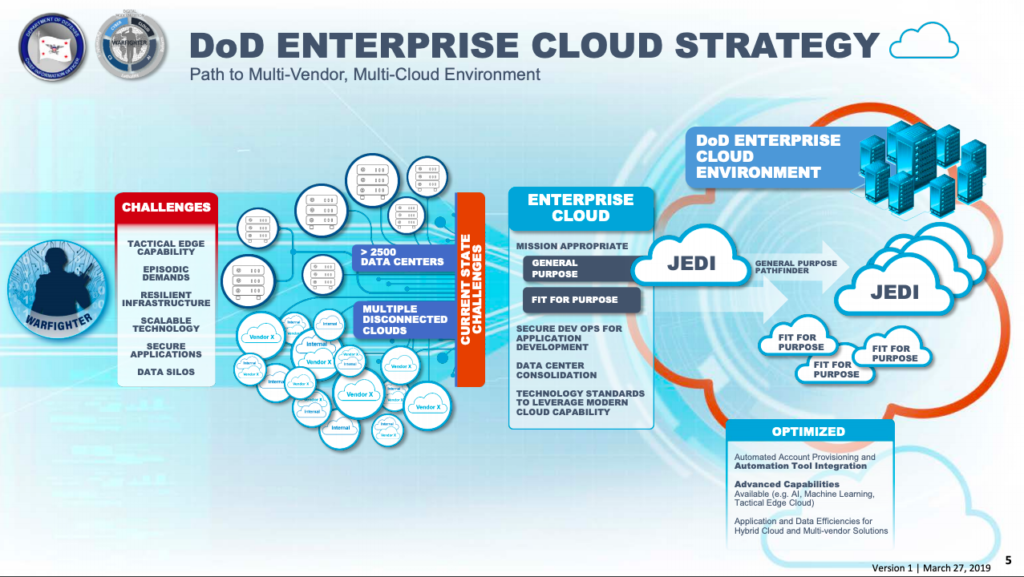
WASHINGTON: The battle over the JEDI cloud computing program is now more tangled than the 11-movie Star Wars saga for which it’s named.
“I have now officially lost track of what the hell is going on,” Bill Greenwalt told me. One of Washington’s most experienced experts in defense procurement, having served both in the Pentagon and on Capitol Hill, Greenwalt threw up his hands this evening after Amazon announced it had just filed a formal protest with the Pentagon over JEDI – even though the company has already taken the Pentagon to court, a far more serious step.
Let’s try to set this straight. Last October, after a competition marred by administrative delays, an earlier lawsuit by Oracle, conflicts of interest and public attacks on Amazon by President Trump, the Defense Department awarded the Joint Enterprise Defense Infrastructure program contract, worth up to $10 billion over 10 years, to Microsoft. Amazon Web Services swiftly filed suit in the Court of Federal Claims. Even the Pentagon has admitted some mistakes, albeit only in one narrow, highly technical evaluation called Price Scenario Six.

Cover of the Defense Department Inspector General report on the JEDI cloud computing competition.
Last month, Judge Patricia Campbell-Smith allowed the Pentagon to correct Price Scenario Six and redo that portion of the process. Amazon opposed the do-over from the start, arguing it ignored not only equally serous flaws in other parts of the process but also the larger issue of possible pressure from President Trump. That’s an issue, incidentally, which the Defense Department barred its own Inspector General from investigating – shortly before Trump fired him.
Tonight, however, Amazon announced it has also filed a formal protest with the Defense Department over the redo. Why?
When DoD issued its amended requirement for Price Scenario Six and ordered Microsoft and Amazon to submit new bids, Amazon thought the amendments were unclear. So, the company said in tonight’s statement, it asked the Pentagon for clarification – repeatedly – but did not get what it considered a “meaningful response.”
So, instead of submitting a bid, Amazon filed what’s known as an “agency protest” with DoD. Now, this kind of protest, to the agency whose actions they dislike, is usually the first and mildest kind of formal objection a company can make. If the agency doesn’t respond in a satisfactory way, the company’s next step is usually to go over its head to Congress’s watchdog, the Government Accountability Office. If GAO also rejects the company’s protest, then the company has to make the hard choice to either give up or escalate to federal court – and it’s rarely a good idea to sue someone you want as a customer.
But Amazon didn’t protest to the GAO. They went directly to court. So why are they now doing something you normally do before going to GAO?

The Pentagon’s plan to consolidate many — but not all — of its 500-plus cloud contracts into one.
I’m still seeking analysis from experts less demoralized by this whole affair than Greenwalt. But having covered defense procurement for two decades myself, I can’t believe Amazon really expects the Defense Department to receive its protest and change its ways in a sudden fit of remorse – not at this stage.
Instead, I suspect this protest is really a signal to the judge. “See, Your Honor?” Amazon can now say. “This redo was so bad, not only did we refuse to bid, we filed a formal protest! Don’t let the Pentagon try to band-aid this competition anymore, just rule in our favor.”
Obviously, Amazon’s lawyers will phrase this more elegantly and less explicitly. But their email to reporters this evening was brutal and blunt:
“From the President’s order to ‘screw’ Amazon out of the contract, to the Secretary halting the award for an 85 day ‘examination,’ to the Secretary’s bizarre recusal after an award decision had been made, to the numerous inexplicable evaluation errors, to the refusal to substantively address AWS’s 265 post-award debriefing questions, to the blatant political interference which impacted the award decision, to the White House instructing DoD witnesses not to answer questions from the Inspector General, to the DoD’s refusal to provide clarification around the amended solicitation – the history of this procurement casts serious doubt on the rationality and fairness of DoD’s correction action.”
Microsoft, meanwhile, learned of Amazon’s protest on Tuesday and published its own rebuttal tonight. “Amazon’s complaint is confidential, so we don’t know what it says,” wrote Microsoft’ VP for communications, Frank Shaw. “However, if their latest complaint mirrors the arguments Amazon made in court, it’s likely yet another attempt to force a re-do because they bid high and lost the first time.”

Dana Deasy
“The only thing that’s certain about Amazon’s new complaint,” Shaw said, “is that it will force American warfighters to wait even longer for the 21st-century technology they need.”
It’s not quite fair to blame Amazon alone for the delay, given how much confusion the Pentagon and President Trump have created over this contract themselves. There’s probably blame enough to go around.
But it’s undeniable that JEDI is much delayed, and the Pentagon seems to have no Plan B to field a technology that could prove valuable, even decisive, in future conflicts.
“Go out to the tactical edge, sit down with the warfighter, and look at how we push information out to someone who’s literally outside of the village on the side of a mountain,” Dana Deasy, the Pentagon CIO, told me Tuesday. “To actually combine that data and physically get the information out to the warfighter in a [device] that they could use when they’re out in the field, it just doesn’t exist today. And no — you cannot pull that off the shelf. That is a unique capability that we have to build.”
Australia unveils ‘historic’ defense boost to 2.4% of GDP in decade, but critics say too little, too late
Part of the shakeup includes tens of billions for nuclear-powered subs, and halting the pricey procurement of an additional F-35 fighter jet squadron.



























